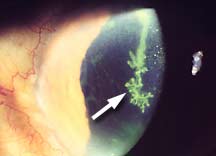Herpes simplex is a very common virus affecting the skin, mucous membranes, nervous system, and the eye. There are two types of herpes simplex. Type I causes cold sores or fever blisters and may involve the eye. Type II is sexually transmitted and rarely causes ocular problems.
Nearly everyone is exposed to the virus during childhood. Herpes simplex is transmitted through bodily fluids, and children are often infected by the saliva of an adult. The initial infection is usually mild, causing only a sore throat or mouth. After exposure, herpes simplex usually lies dormant in the nerves that supply the eye and skin.
Later on, the virus may be reactivated by stress, heat, running a fever, sunlight, hormonal changes, trauma, or certain medications. It is more likely to recur in people who have diseases that suppress their immune system. In some cases, the recurrence is triggered repeatedly and becomes a chronic problem.
When the eye is involved, herpes simplex typically affects the eyelids, conjunctiva, and cornea. Keratitis (swelling caused by the infection), a problem affecting the cornea, is often the first ocular sign of the disease. In some cases, the infection extends to the middle layers of the cornea, increasing the possibility of permanent scarring. Some patients develop uveitis, an inflammatory condition that affects other eye tissues.
Signs and Symptoms
- Pain
- Red eye
- Tearing
- Light sensitivity
- Irritation, scratchiness
- Decreased vision (dependent on the location and extent of the infection)
Detection and Diagnosis
Herpes simplex is diagnosed with a slit lamp examination. Tinted eye drops that highlight the affected areas of the cornea may be instilled to help the eye care practitioner evaluate the extent of the infection.
Treatment
Treatment of herpes simplex keratitis depends on the severity. An initial outbreak is typically treated with topical and sometimes oral anti-viral medication. The ophthalmologist may gently scrape the affected area of the cornea to remove the diseased cells. Patients who experience permanent corneal scarring as a result of severe and recurrent infections may require a corneal transplant to restore their vision.
Illustrations by Mark Erickson
With acknowledgement to St. Lukes Eye Hospital.
